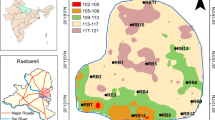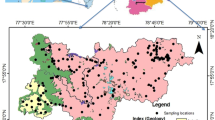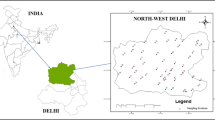Abstract
The study region comprises fractured granitic, basaltic and lateritic aquifer system constituted by Precambrian rocks. Groundwater is the primary source for drinking and household needs. Its quality is a big issue in the three aquifers, which are mostly of human health concern. Many developing regions suffer from lack of safe drinking water, thereby health problems arise in many parts of the regions, and Telangana state is one of them. For this reason, 194 groundwater samples were collected and analyzed for fluoride, nitrate, chloride and other physicochemical parameters. The concentrations of fluoride (F−), nitrate (NO3−), magnesium (Mg2+), total dissolved solids and total hardness are above the acceptable limits for drinking purposes, prescribed by the World Health Organization. The higher concentrations of fluoride and nitrate in drinking water cause health hazards, and above 50% of the groundwater samples are not suitable for drinking purposes with respect to fluoride and nitrate. Weathering of rocks and dissolution of fluoride-bearing minerals can be a cause for higher fluoride concentrations, while anthropogenic sources are one of the major reasons for higher nitrate concentrations in the study area. Groundwater suitability for irrigation suggests that more than 90% of the groundwater sampling locations are suitable for irrigation. In addition, health risk assessments were evaluated by using the United States Environmental Protection Agency model, to determine the non-carcinogenic risk of fluoride and nitrate in drinking water for adults (females and males) and children. The ranges of hazard index in all sampling locations are varied from 0.133 to 8.870 for males, 0.146 to 10.293 for females and 0.419 to 29.487 for children, respectively. The health risk assessment results indicated that children were more exposed to health risk, due to the intake of high contaminated drinking water with respective of nitrate and fluoride in the study region.

















Similar content being viewed by others
References
Aboubakar, S., Ousmane, B., & Aridjima, G. (2016). Hydrogeochemical processes controlling groundwater quality around Bomboré gold mineralized zone, Central Burkina Faso. Journal of Geochemical Exploration,170, 58–71. https://doi.org/10.1016/j.gexplo.2016.08.009.
Adimalla, N. (2019a). Groundwater quality for drinking and irrigation purposes and potential health risks assessment: A case study from semi-arid region of South India. Exposure and Health,11(2), 109–123. https://doi.org/10.1007/s12403-018-0288-8.
Adimalla, N. (2019b). Spatial distribution, exposure, and potential health risk assessment from nitrate in drinking water from semi-arid region of South India. Human and Ecological Risk Assessment: An International Journal. https://doi.org/10.1080/10807039.2018.1508329.
Adimalla, N., & Li, P. (2019). Occurrence, health risks, and geochemical mechanisms of fluoride and nitrate in groundwater of the rock-dominant semi-arid region, Telangana State, India. Human and Ecological Risk Assessment: An International Journal,25(1–2), 81–103. https://doi.org/10.1080/10807039.2018.1480353.
Adimalla, N., Li, P., & Qian, H. (2018a). Evaluation of groundwater contamination for fluoride and nitrate in semi-arid region of Nirmal Province, South India: A special emphasis on human health risk assessment (HHRA). Human and Ecological Risk Assessment: An International Journal. https://doi.org/10.1080/10807039.2018.1460579.
Adimalla, N., Li, P., & Venkatayogi, S. (2018b). Hydrogeochemical evaluation of groundwater quality for drinking and irrigation purposes and integrated interpretation with water quality index studies. Environmental Processes,5(2), 363–383. https://doi.org/10.1007/s40710-018-0297-4.
Adimalla, N., Marsetty, S. K., & Xu, P. (2019a). Assessing groundwater quality and health risks of fluoride pollution in the Shasler Vagu (SV) watershed of Nalgonda, India. Human and Ecological Risk Assessment: An International Journal. https://doi.org/10.1080/10807039.2019.1594154.
Adimalla, N., & Qian, H. (2019a). Groundwater quality evaluation using water quality index (WQI) for drinking purposes and human health risk (HHR) assessment in an agricultural region of Nanganur, south India. Ecotoxicology and Environmental Safety,176, 153–161. https://doi.org/10.1016/j.ecoenv.2019.03.066.
Adimalla, N., & Qian, H. (2019b). Hydrogeochemistry and fluoride contamination in the hard rock terrain of central Telangana, India: Analyses of its spatial distribution and health risk. SN Applied Sciences,1(3), 202. https://doi.org/10.1007/s42452-019-0219-8.
Adimalla, N., Vasa, S. K., & Li, P. (2018c). Evaluation of groundwater quality, Peddavagu in Central Telangana (PCT), South India: An insight of controlling factors of fluoride enrichment. Modeling Earth Systems and Environment,4(2), 841–852. https://doi.org/10.1007/s40808-018-0443-z.
Adimalla, N., & Venkatayogi, S. (2017). Mechanism of fluoride enrichment in groundwater of hard rock aquifers in Medak, Telangana State, South India. Environmental Earth Sciences. https://doi.org/10.1007/s12665-016-6362-2.
Adimalla, N., & Venkatayogi, S. (2018). Geochemical characterization and evaluation of groundwater suitability for domestic and agricultural utility in semi-arid region of Basara, Telangana State, South India. Applied Water Science,8(1), 44. https://doi.org/10.1007/s13201-018-0682-1.
Adimalla, N., Venkatayogi, S., & Das, S. V. G. (2019b). Assessment of fluoride contamination and distribution: A case study from a rural part of Andhra Pradesh, India. Applied Water Science,9(4), 94. https://doi.org/10.1007/s13201-019-0968-y.
Adimalla, N., & Wu, J. (2019). Groundwater quality and associated health risks in a semi-arid region of south India: Implication to sustainable groundwater management. Human and Ecological Risk Assessment: An International Journal,25(1–2), 191–216. https://doi.org/10.1080/10807039.2018.1546550.
Aly, A. A., Al-Omran, A. M., & Alharby, M. M. (2014). The water quality index and hydrochemical characterization of groundwater resources in Hafar Albatin. Saudi Arabia: Arab J Geosci. https://doi.org/10.1007/s12517-014-1463-2.
APHA. (1995). Standard methods for estimation of water and waste water (19th ed.). Washington, DC: American Public Health Association.
Ashwani, K. T., Marina, D. M., Prasoon, K. S., & Abhay, K. S. (2016). Hydrogeochemical characterization and groundwater quality assessment in a coal mining area, India. Arabian Journal of Geosciences,9, 177. https://doi.org/10.1007/s12517-015-2209-5.
Bachaer, A., Ikram, J., Samir, S., Naziha, M., Salwa, S., Emna, B., et al. (2017). Hydrochemical characterization of groundwater using multivariate statistical analysis: The Maritime Djeffara shallow aquifer (Southeastern Tunisia). Environmental Earth Sciences,76, 821. https://doi.org/10.1007/s12665-017-7168-6.
Brindha, K., Rajesh, R., Murugan, R., & Elango, L. (2011). Fluoride contamination in groundwater in parts of Nalgonda district, Andhra Pradesh, India. Environmental Monitoring and Assessment,172, 481–492.
Canter, L. W. (1997). Nitrate in groundwater (p. 263). New York: Lewish Publishers.
CGWB. (1999). High incidence of arsenic in groundwater in West Bengal. Central Ground Water Board, Ministry of Water Resources, Government of India.
Chen, J., Qian, H., & Wu, H. (2017a). Nitrogen contamination in groundwater in an agricultural region along the New Silk Road, northwest China: Distribution and factors controlling its fate. Environmental Science and Pollution Research,24(15), 13154–13167.
Chen, J., Wu, H., Qian, H., & Gao, Y. (2017b). Assessing nitrate and fluoride contaminants in drinking water and their health risk of rural residents living in a semiarid region of Northwest China. Exposure and Health,9(3), 183–195.
Chung, S. Y., Ramkumar, T., Venkatramanan, S., Kim, T. H., & Kim, D. S. (2014). Influence of hydrogeochemical processes and assessment of suitability for groundwater uses in Busan City. Korea: Environ Dev Sustain. https://doi.org/10.1007/s10668-014-9552-7.
Davis, S. N., & De Wiest, R. J. M. (1966). Hydrogeology (p. 463). New York: Wiley.
Domenico, P. A., & Schwartz, F. W. (1990). Physical and chemical hydrogeology. New York: Wiley.
Eaton, E. M. (1950). Significance of carbonates in irrigation waters. Soil Science,69, 123–133.
Eickhout, B., Bouwman, A. F., & Van, Z. H. (2006). The role of nitrogen in world food production and environmental sustainability. Agriculture, Ecosystems & Environment,116, 4–14.
Esmaeil, K., & William, M. H. (2017). Applicability of geochemical techniques and artificial sweeteners in discriminating the anthropogenic sources of chloride in shallow groundwater north of Toronto, Canada. Environmental Monitoring and Assessment,189, 218. https://doi.org/10.1007/s10661-017-5927-1.
Fan, A. M. (2011). Nitrate and nitrite in drinking water: A toxicological review. Encyclopedia of Environmental Health, 137–145.
Faten, H., Rim, A., Abdelkrim, C., & Mourad, B. (2016). purposes and identification of hydrogeochemical mechanisms evolution in Northeastern, Tunisia. Environmental Earth Sciences,75, 746. https://doi.org/10.1007/s12665-016-5441-8.
Fewtrell, L. (2004). Drinking-water nitrate, methemoglobinemia, and global burden of disease: A discussion. Environmental Health Perspectives,112(14), 1371–1374.
Gibbs, R. J. (1970). Mechanisms controlling world water chemistry. Science,170, 795–840.
Gillberg, M. (1964). Halogen and hydroxyl contents of micas and amphiboles in Swedish granite rocks. Geochimica et Cosmochimica Acta,28, 495–516.
Gnanachandrasamy, G., Ramkumar, T., Venkatramanan, S., Vasudevan, S., Chung, S. Y., & Bagyaraj, M. (2014). Accessing groundwater quality in lower part of Nagapattinam District, Southern India: Using hydrogeochemistry and GIS interpolation techniques. Applied Water Science,5, 39–55.
Guler, C., Kurt, M. A., Alpaslan, M., & Akbulut, C. (2012). Assessment of the impact of anthropogenic activities on the groundwater hydrology and chemistry in Tarsus coastal plain (Mersin, SE Turkey) using fuzzy clustering, multivariate statistics and GIS techniques. Journal of Hydrology,414–415, 435–451. https://doi.org/10.1016/j.jhydrol.2011.11.021.
Gupta, S. K., Gupta, R. C., Gupta, A. B., Seth, A. K., Bassin, J. K., & Gupta, A. (2000). Recurrent acute respiratory tract infections in areas with high nitrate concentrations in drinking water. Environmental Health Perspectives,108(4), 363–366.
Hamid, R. N., & Zahra, K. (2013). Source of salinity in the groundwater of Lenjanat Plain, Isfahan, Iran. Environmental Earth Sciences,68, 413–427. https://doi.org/10.1007/s12665-012-1746-4.
Hamilton, P. A., & Helsel, D. R. (1995). Effects of agriculture on groundwater quality in five regions of the United States. Ground Water,33, 217–226.
Hem, J. D. (1992). Study and interpretation of chemical characteristics of natural water, 3rd edn. USGS Water-Supply Paper 2254.
Hill, M. J. (1999). Nitrate toxicity: Myth or reality? British Journal of Nutrition,81, 343–344.
ICMR. (2009). Nutrient requirements and recommended dietary allowances for Indians. A Report of the Expert Group of the Indian Council of Medical Research.
Islam, S. M. D. U., Majumder, R. K., Uddin, M. J., et al. (2017). Hydrochemical characteristics and quality assessment of groundwater in Patuakhali District, Southern Coastal Region of Bangladesh. Expo Health,9, 43–60. https://doi.org/10.1007/s12403-016-0221-y.
Jalali, M. (2005). Nitrates leaching from agricultural land in Hamadan, western Iran. Agriculture, Ecosystems & Environment,110, 210–218.
Jalali, M. (2011). Nitrate pollution of groundwater in Toyserkan, western Iran. Environmental Earth Sciences,62(5), 907–913. https://doi.org/10.1007/s12665-010-0576-5.
Karanth, K. R. (1987). Groundwater assessment, development and management. New Delhi: Tata-McGraw-Hill.
Kelly, W. P. (1963). Use of saline irrigation water. Soil Science,95, 355–391. https://doi.org/10.1097/00010694-196306000-00003.
Kumaran, P., Bhargava, G. N., & Bhakuni, T. S. (1971). Fluorides in groundwater and endemic fluorosis in Rajasthan. Indian Journal of Environmental Health,13, 316–324.
Latu, K., Gogoi, R. R., Das, N., Deka, J. P., Das, A., Kumar, M., et al. (2017). Groundwater appraisal of Dhekiajuli, Assam, India: An insight of agricultural suitability and arsenic enrichment. Environmental Earth Sciences,76, 530. https://doi.org/10.1007/s12665-017-6841-0.
Li, P., Wu, J., & Hui, Q. (2016). Hydrochemical appraisal of groundwater quality for drinking and irrigation purposes and the major influencing factors: A case study in and around Hua County, China. Arabian Journal of Geosciences,9, 15. https://doi.org/10.1007/s12517-015-2059-1.
Liu, C. W., Lin, C. N., Jang, C. S., et al. (2011). Assessing nitrate contamination and its potential health risk to Kinmen residents. Environmental Geochemistry and Health,33(5), 503–514. https://doi.org/10.1007/s10653-010-9367-x.
Majumdar, D., & Gupta, N. (2000). Nitrate pollution of groundwater and associated human health disorders. Indian Journal of Environmental Health,42, 28–39.
Masood, A., Sumbul, R., & Mohd, A. (2012). Hydrochemical investigation and quality assessment of groundwater in rural areas of Delhi, India. Environmental Earth Sciences,66, 97–110. https://doi.org/10.1007/s12665-011-1210-x.
Metcalf, & Eddy. (1979). Wastewater engineering treatment, disposal and reuse. New York: McGraw Hill.
Mukherjee, I., & Singh, U. K. (2018). Groundwater fluoride contamination, probable release, and containment mechanisms: A review on Indian context. Environmental Geochemistry and Health,40(6), 2259–2301.
Nadia, E. H., Kenneth, P. C., Nuria, M., et al. (2015). Nitrate in drinking water and bladder cancer risk in Spain. Environmental Research,137, 299–307.
Nagaraju, A., Sunil Kumar, K., & Thejaswi, A. (2014). Assessment of groundwater quality for irrigation: A case study from Bandalamottu lead mining area, Guntur District, Andhra Pradesh, South India. Applied Water Science,4, 385–396. https://doi.org/10.1007/s13201-014-0154-1.
Narsimha, A., & Rajitha, S. (2018). Spatial distribution and seasonal variation in fluoride enrichment in groundwater and its associated human health risk assessment in Telangana State, South India. Human and Ecological Risk Assessment: An International Journal,24(8), 2119–2132. https://doi.org/10.1080/10807039.2018.1438176.
Narsimha, A., & Sudarshan, V. (2013). Hydrogeochemistry of groundwater in Basara area, Adilabad District, Andhra Pradesh, India. Journal Applied Geochemistry,15(2), 224–237.
Narsimha, A., & Sudarshan, V. (2017a). Assessment of fluoride contamination in groundwater from Basara, Adilabad District, Telangana State, India. Applied Water Science,7(6), 2717–2725. https://doi.org/10.1007/s13201-016-0489-x.
Narsimha, A., & Sudarshan, V. (2017b). Contamination of fluoride in groundwater and its effect on human health: A case study in hard rock aquifers of Siddipet, Telangana State, India. Applied Water Science,7(5), 2501–2512. https://doi.org/10.1007/s13201-016-0441-0.
Narsimha, A., & Sudarshan, V. (2018a). Data on fluoride concentration levels in semi-arid region of Medak, Telangana, South India. Data in Brief,16, 717–723.
Narsimha, A., & Sudarshan, V. (2018b). Drinking water pollution with respective of fluoride in the semi-arid region of Basara, Nirmal district, Telangana State, India. Data in Brief,16, 752–757. https://doi.org/10.1016/j.dib.2017.11.087.
Piper, A. M. (1944). A graphical procedure in the geochemical interpretation of water analysis. Transactions American Geophysical Union,25, 914–928.
Ramakrishnalah, C. R., Sadas Hivalah, C., & Ranganna, G. (2009). Assessment of water quality index for the groundwater in Tumkur Taluk, Karnataka state, India. European Journal of Chemistry,6(2), 523–530.
Ramya, P. R., & Elango, L. (2018). Evaluation of geogenic and anthropogenic impacts on spatiotemporal variation in quality of surface water and groundwater along Cauvery River, India. Environmental Earth Sciences -,77, 2. https://doi.org/10.1007/s12665-017-7176-6.
Rao, N. S., Rao, P. S., Dinakar, A., Rao, P. V. N., & Marghade, D. (2017). Fluoride occurrence in the groundwater in a coastal region of Andhra Pradesh, Applied Water Science,7(3), 1467–1478.
Richards, L. A. (Ed.). (1954). Diagnosis and improvement of saline and alkali soils: Agriculture, vol 160, Handbook 60. Washington DC: U.S. Department of Agriculture.
Ronggao, Q., Yanqing, W., Zengguang, X., Derrick, X., & Chi, Z. (2013). Assessing the impact of natural and anthropogenic activities on groundwater quality in coastal alluvial aquifers of the lower Liaohe River Plain, NE China. Applied Geochemistry,31, 142–158. https://doi.org/10.1016/j.apgeochem.2013.01.001.
Sakram, G., & Adimalla, N. (2018). Hydrogeochemical characterization and assessment of water suitability for drinking and irrigation in crystalline rocks of Mothkur region, Telangana State, South India. Applied Water Science,8(5), 143. https://doi.org/10.1007/s13201-018-0787-6.
Schoeller, H. (1967). Geochemistry of groundwater. An international guide for research and practice, chap. 15 (pp. 1–18). Paris: UNESCO.
Subba Rao, N., Marghade, D., Dinakar, A., Chandana, I., Sunitha, B., Ravindra, B., et al. (2017). Geochemical characteristics and controlling factors of chemical composition of groundwater in a part of Guntur district, Andhra Pradesh, India. Environmental Earth Sciences,76, 747. https://doi.org/10.1007/s12665-017-7093-8.
Susheela, A. K. (1999). Fluorosis management programme in India. Current Science,77, 1250–1256.
Suthar, S., Bishnoi, P., Singh, S., Mutiyar, P. K., Nema, A. K., & Patil, N. S. (2009). Nitrate contamination in groundwater of some rural areas of Rajasthan, India. Journal of Hazardous Materials,171, 189–199.
Tai, T., Wang, J., Wang, Y., & Bai, L. (2012). Groundwater pollution risk evaluation method research progress in our country. Journal of Beijing Normal University Natural Science,06, 648–653.
Teotia, S. P. S., Teotia, M., & Singh, R. K. (1981). Hydrogeochemical aspects of endemic skeletal fluorosis in India—an epidemiological study. Fluoride,14, 69–74.
Thorburn, P. J., Biggs, J. S., Weier, K. L., & Keating, B. A. (2003). Nitrate in groundwater of intensive agricultural areas in coastal Northeastern Australia. Agriculture, Ecosystems & Environment,94, 49–58.
Todd, D. K. (1980). Groundwater hydrology. New York: Wiley Publications.
UN-Water FAO. (2007). Challenge of the twenty-first century. http://www.un.org/waterforlifedecade/scarcity.shtml.
US Geological Survey. (2000). Classification of natural ponds and lakes. Washington: U.S. Department of the Interior, U.S. Geological Survey.
US Salinity Laboratory. (1954). Diagnosis and improvement of saline and alkali soils. Agricultural handbook (Vol. 60, p. 160). Washington: USDA.
USEPA. (1989). Risk assessment guidance for superfund, vol I., human health evaluation manual (Part A) office of emergency and remedial response. Washington, DC: USEPA.
USEPA. (2012). Integrated risk information system. United States Environmental Protection Agency. http://cfpub.epa.gov/ncea/iris/index.cfm?fuseaction_iris.showSubstanceList. Accessed 3 May 2012.
Wedepohl, K. H. (1969). Handbook of geochemistry (Vol. vol II-l). Berlin: Springer.
WHO. (2011). Guidelines for drinking water quality. Geneva: World Health Organization.
WHO. (2013). World health statistics. Geneva: WHO. ISBN 978-92-4-156458-8.
Wilcox, L. V. (1955). Classification and use of irrigation water (p. 19). Washington: U.S. Department of Agriculture Circular 969.
World Bank. (2010). Deep wells and prudence: Towards pragmatic action for addressing groundwater overexploitation in India. Washington: World Bank.
Wu, J., & Sun, Z. (2016). Evaluation of shallow groundwater contamination and associated human health risk in an alluvial plain impacted by agricultural and industrial activities, mid-west China. Expo Health,8(3), 311–329. https://doi.org/10.1007/s12403-015-0170-x.
Zhang, Y., Wu, J., & Xu, B. (2018). Human health risk assessment of groundwater nitrogen pollution in Jinghui canal irrigation area of the loess region, northwest China. Environmental Earth Sciences,77(7), 273. https://doi.org/10.1007/s12665-018-7456-9.
Acknowledgements
This research work was financially supported by Narsimha Adimalla from the Department of Science and Technology (DST)—Science and Engineering Research Board (SERB) Government of India, New Delhi, under the Start-Up Research Grant (Young Scientists) project (SR/FTP/ES-13/2013), which is gratefully acknowledged. I would like to thank the Editor-in-Chief and anonymous reviewers for their valuable and constructive suggestions to improve the text in the present form.
Author information
Authors and Affiliations
Corresponding author
Additional information
Publisher's Note
Springer Nature remains neutral with regard to jurisdictional claims in published maps and institutional affiliations.
Electronic supplementary material
Below is the link to the electronic supplementary material.
Rights and permissions
About this article
Cite this article
Adimalla, N. Controlling factors and mechanism of groundwater quality variation in semiarid region of South India: an approach of water quality index (WQI) and health risk assessment (HRA). Environ Geochem Health 42, 1725–1752 (2020). https://doi.org/10.1007/s10653-019-00374-8
Received:
Accepted:
Published:
Issue Date:
DOI: https://doi.org/10.1007/s10653-019-00374-8




